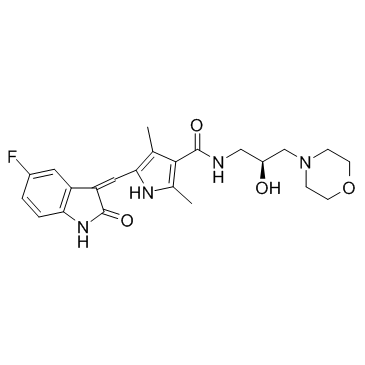| Description |
SU14813 is a multi-targeted receptor tyrosine kinases inhibitor with IC50s of 50, 2, 4, 15 nM for VEGFR2, VEGFR1, PDGFRβ and KIT.
|
| Related Catalog |
|
| Target |
VEGFR1:2 nM (IC50)
VEGFR2:50 nM (IC50)
PDGFRβ:4 nM (IC50)
KIT:15 nM (IC50)
|
| In Vitro |
SU14813 inhibits ligand-dependent and ligand-independent proliferation, migration, and survival of endothelial cells and/or tumor cells expressing these targets. SU14813 inhibits cellular ligand-dependent phosphorylation of VEGFR-2 (transfected NIH 3T3 cells), PDGFR-β (transfected NIH 3T3 cells), KIT (Mo7e cells), and FLT3-internal tandem duplication (FLT3-ITD; MV4;11 cells) as well as FMS/CSF1R (transfected NIH 3T3 cells). SU14813 inhibits VEGFR-2, PDGFR-β, and KIT phosphorylation in porcine aorta endothelial cells overexpressing these targets, with cellular IC50 values of 5.2, 9.9, and 11.2 nM, respectively. SU14813 inhibits the growth of U-118MG with an IC50 of 50 to 100 nM[1].
|
| In Vivo |
SU14813 inhibits VEGFR-2, PDGFR-β, and FLT3 phosphorylation in xenograft tumors in a dose- and time-dependent fashion. The plasma concentration required for in vivo target inhibition is estimated to be 100 to 200 ng/mL. Used as monotherapy, SU14813 exhibits broad and potent antitumor activity resulting in regression, growth arrest, or substantially reduces growth of various established xenografts derived from human or rat tumor cell lines. Treatment in combination with docetaxel significantly enhances both the inhibition of primary tumor growth and the survival of the tumor-bearing mice compared with administration of either agent alone[1].
|
| Cell Assay |
The effect of SU14813 on endothelial cell survival is evaluated. Passages 4 to 5 human umbilical vein endothelial cells are grown to subconfluency in EGM2 medium containing 10% FBS, endothelial cell growth supplement, and 10 μg/mL sodium heparin. The cells are seeded in 96-well plates at 10,000 per well in F12K medium and 10% FBS. The next day, cells are starved for 18 hours in F12K+1% FBS and then incubated with SU14813 in various concentrations. 45 minutes later, 20 ng/mL growth factor [VEGF or basic fibroblast growth factor (bFGF)] is introduced into the assay. Three days later, cell numbers are determined using the 3-(4,5-dimethylthiazol-2-yl)-2,5-diphenyltetrazolium bromide assay[1].
|
| Animal Admin |
Mouse: SU14813 is evaluated for its efficacy and synergism in combination with the microtubule inhibitor docetaxel in docetaxel-resistant murine LLC model. SU14813 is administered p.o. twice daily (BID) at doses of 10, 40, 80, or 120 mg/kg beginning on day 5 after tumor implantation. Docetaxel 40 mg/kg (mouse maximum tolerated dose) is administered i.v. thrice weekly also beginning on day 5 after tumor implantation[1].
|
| References |
[1]. Patyna S, et al. SU14813: a novel multiple receptor tyrosine kinase inhibitor with potent antiangiogenic and antitumor activity. Mol Cancer Ther. 2006 Jul;5(7):1774-82.
|
